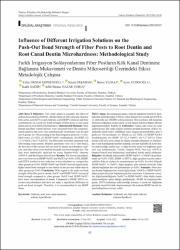Influence of different irrigation solutions on the push-out bond strength of fiber posts to root dentin and root canal dentin microhardness: methodological study

View/
Access
info:eu-repo/semantics/openAccessDate
2023Author
Hepşenoğlu, Yelda ErdemErşahan, Şeyda
Yılmaz, Burcu
Aydınoğlu, Aysu
Sağır, Kadir
Yoruç, Afife Binnaz Hazar
Metadata
Show full item recordCitation
Sağır, K., Hepşenoğlu, Yelda E., Yılmaz, B., Yoruç, Afife Binnaz H., Aydınoğlu, A. (2023). Influence of different irrigation solutions on the push-out bond strength of fiber posts to root dentin and root canal dentin microhardness: methodological study. 29 (1), 83-91.Abstract
This study aimed to compare the effect of
sodium hypochlorite (NaOCl), chlorhexidine (CHX), ethylene diamine
tetra acetic acid (EDTA) and etidronic acid (HEBP) solutions and their
combinations on a push-out bond strength of fiber posts to root canal
dentin and on root dentin microhardness. Material and Methods: Sixty
human maxillary central incisors were sectioned below the cementoenamel junction, the roots were endodontically treated and were divided
into 6 groups (n=10) according to the final irrigation protocol: (1) Distilled water, (2) CHX, (3) HEBP-NaOCl combination, (4) HEBP, (5)
2.5 % NaOCl, (6) 17% EDTA. The fiber posts were then cemented with
self-etching resin cement. Bonded specimens were cut (1-mm-thick),
the first slice of the coronal 3rd was used for dentin microhardness analysis, and other slices were used for the push-out bond strength test. The
data were statistically analyzed by using Shapiro-Wilk, Oneway
ANOVA, and the Games-Howell test. Results: The lowest microhardness was observed in HEBP-NaOCl and NaOCl (p<0.05). CHX, HEBP,
and EDTA resulted in less reduction in microhardness as compared to
other groups (p<0.05). HEBP-NaOCl and NaOCl showed significantly
higher mean bond strength to root dentin in the cervical thirds than in
other groups (p<0.05). Conclusion: With regard to the push-out bond
strength of the fiber post to dentin, NaOCl and HEBP-NaOCl increased
bond strength compared to other groups. NaOCl and HEBP-NaOCl
have lower microhardness of dentin. Compared to HEBP, EDTA increases microhardness and does not make a significant difference in
push-out bond strength. Therefore, it is recommended to use HEBP
alone. : Bu çalışmanın amacı, sodyum hipoklorit (NaOCl), klorheksidin [chlorhexidine (CHX)], etilen diamin tetra asetik asit (EDTA)
ve etidronik asit (HEBP) solüsyonlarının fiber postların kök kanalına
dentinine bağlanma mukavemeti ve kök dentin mikrosertliğine etkisini
değerlendirmektir. Gereç ve Yöntemler: Altmış adet insan üst çene
santral kesici dişi mine sement sınırının altından kesilerek, kökler endodontik olarak tedavi edildikten sonra irrigasyon protokolüne göre 6
gruba (n=10) ayrılmıştır: (1) Distile su, (2) CHX, (3) HEBP-NaOCl
kombinasyonu, (4) HEBP, (5) %2,5 NaOCl, (6) %17 EDTA. Fiber
postlar self-etch rezin siman ile dişlere simante edilmiştir ve örneklerden 1 mm kalınlığında kesitler alınarak, koronal üçlüdeki ilk kesit dentin mikrosertliği analizi için ve diğer kesitler push-out bağlanma gücü
testi için kullanılmıştır. Veriler, Shapiro-Wilk, One-way ANOVA,
Games-Howell testi kullanılarak istatistiksel olarak analiz edilmiştir.
Bulgular: En düşük mikrosertlik HEBP-NaOCl ve NaOCl’de gözlenmiştir (p<0,05). CHX, HEBP ve EDTA, diğer gruplara kıyasla mikrosertlikte daha az azalma ile sonuçlanmıştır (p<0,05). Servikal bölgede
HEBP-NaOCl ve NaOCl, diğer gruplara göre anlamlı derecede daha
yüksek bağlanma kuvveti göstermiştir (p<0,05). Sonuçlar: Fiber postun dentine bağlanma kuvvetiyle ilgili olarak, NaOCl ve HEBP-NaOCl,
diğer gruplara kıyasla bağlanma gücünü artırmıştır. Çalışmanın sonuçları değerlendirildiğinde, NaOCl ve HEBP-NaOCl, daha düşük dentin
mikrosertliğine sahip olduğu görülmüştür. HEBP ile karşılaştırıldığında, EDTA kullanımı mikrosertliği artırmış ve push-out bağlanma
gücünde önemli bir fark oluşturmamıştır. Bu nedenle HEBP’nin tek başına kullanılması tavsiye edilir.
















